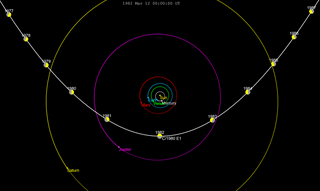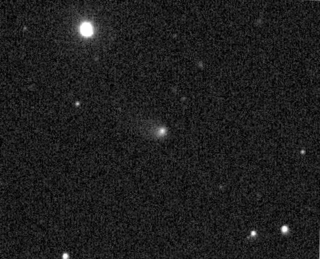Related Research Articles

Comet Machholz, formally designated C/2004 Q2, is a long-period comet discovered by Donald Machholz on August 27, 2004. It reached naked eye brightness in January 2005. Unusual for such a relatively bright comet, its perihelion was farther from the Sun than the Earth's orbit.

JPL Horizons On-Line Ephemeris System provides access to key Solar System data and flexible production of highly accurate ephemerides for Solar System objects.

C/2007 E2 (Lovejoy) is a non-periodic comet discovered by Terry Lovejoy on 15 March 2007. Its perihelion was 27 March 2007, while its closest approach to Earth was 25 April 2007 in Hercules at a distance of 0.44 AU. Maximum apparent magnitude was approximately +8.

(308933) 2006 SQ372 is a trans-Neptunian object and highly eccentric centaur on a cometary-like orbit in the outer region of the Solar System, approximately 123 kilometers (76 miles) in diameter. It was discovered through the Sloan Digital Sky Survey by astronomers Andrew Becker, Andrew Puckett and Jeremy Kubica on images first taken on 27 September 2006 (with precovery images dated to 13 September 2005).

C/1992 J1 (Spacewatch) is a comet that was discovered 1 May 1992 by David Rabinowitz of the Spacewatch Project. This was the first comet to be discovered using an automated system.

C/1980 E1 is a non-periodic comet discovered by Edward L. G. Bowell on 11 February 1980 and which came closest to the Sun (perihelion) in March 1982. It is leaving the Solar System on a hyperbolic trajectory due to a close approach to Jupiter. In the 43 years since its discovery only two objects with higher eccentricities have been identified, 1I/ʻOumuamua (1.2) and 2I/Borisov (3.35).

C/2007 Q3 , is an Oort cloud comet that was discovered by Donna Burton in 2007 at Siding Spring Observatory in New South Wales, Australia. Siding Spring came within 1.2 astronomical units of Earth and 2.25 AU of the Sun on October 7, 2009. The comet was visible with binoculars until January 2010.
C/2000 W1 (Utsunomiya–Jones) is a long-period comet from the Oort cloud discovered on November 18, 2000, by Syogo Utsunomiya and Albert F. A. L. Jones. The comet reached up to apparent magnitude 5.5, but was only 27 degrees from the Sun in mid-December 2000.

C/1999 S4 (LINEAR) was a long-period comet discovered on September 27, 1999, by LINEAR.

C/2013 V5 (Oukaimeden) is a retrograde Oort cloud comet discovered on 12 November 2013 by Oukaimeden Observatory at an apparent magnitude of 19.4 using a 0.5-meter (20 in) reflecting telescope.

C/2013 US10 (Catalina) is an Oort cloud comet discovered on 31 October 2013 by the Catalina Sky Survey at an apparent magnitude of 19 using a 0.68-meter (27 in) Schmidt–Cassegrain telescope. From September 2015 to February 2016 the comet was around apparent magnitude 6. The comet took around a million years to complete half an orbit from its furthest distance in the Oort cloud and should be ejected from the Solar System over many millions of years.

C/2017 K2 (PanSTARRS) is an Oort cloud comet with an inbound hyperbolic orbit, discovered in May 2017 at a distance beyond the orbit of Saturn when it was 16 AU (2.4 billion km) from the Sun. Precovery images from 2013 were located by July. It had been in the constellation of Draco from July 2007 until August 2020. As of June 2022, the 3-sigma uncertainty in the current distance of the comet from the Sun is ±6000 km.

C/2017 U7 (PanSTARRS) is a hyperbolic comet, first observed on 29 October 2017 by astronomers of the Pan-STARRS facility at Haleakala Observatory, Hawaii, United States when the object was 7.8 AU (1.2 billion km) from the Sun. Despite being discovered only 10 days after interstellar asteroid 1I/'Oumuamua, it was not announced until March 2018 as its orbit is not strongly hyperbolic beyond most Oort Cloud comets. Based on the absolute magnitude of 10.6, it may measure tens of kilometers in diameter. As of August 2018, there is only 1 hyperbolic asteroid known, ʻOumuamua, but hundreds of hyperbolic comets are known.

C/2018 C2 (Lemmon) is a hyperbolic comet. It was first observed on 5 February 2018 by the Mount Lemmon Survey conducted at the Mount Lemmon Observatory near Tucson, Arizona, in the United States. The discovery was announced on 4 March 2018 along with another hyperbolic object, A/2017 U7. Based on the absolute magnitude of 15.1, it may measure several kilometers in diameter. On 22 March 2018 it was determined to be a hyperbolic comet.

C/2014 UN271 (Bernardinelli–Bernstein), simply known as C/2014 UN271 or Comet Bernardinelli–Bernstein (nicknamed BB), is a large Oort cloud comet discovered by astronomers Pedro Bernardinelli and Gary Bernstein in archival images from the Dark Energy Survey. When first imaged in October 2014, the object was 29 AU (4.3 billion km; 2.7 billion mi) from the Sun, almost as far as Neptune's orbit and the greatest distance at which a comet has been discovered. With a nucleus diameter of at least 120 km (75 mi), it is the largest Oort cloud comet known. It is approaching the Sun and will reach its perihelion of 10.9 AU (just outside of Saturn's orbit) in January 2031. It will not be visible to the naked eye because it will not enter the inner Solar System.
C/2010 U3 (Boattini) is the hyperbolic comet with the longest observation arc and took around a million years to complete half an orbit from its furthest distance in the Oort cloud. It was discovered on 31 October 2010 by Andrea Boattini in images taken with the Mount Lemmon Survey's 1.5-m reflector. The perihelion point is outside of the inner Solar System.
C/2021 O3 (PanSTARRS) is perhaps an Oort cloud comet, discovered on 26 July 2021 by the Pan-STARRS sky survey. It came to perihelion on 21 April 2022 at 0.287 AU (42.9 million km). from the Sun.
C/2002 VQ94 (LINEAR) is a long period comet with a comet nucleus estimated to be ≈100 km in diameter. It was discovered on 11 November 2002 by LINEAR. It only brightened to total apparent magnitude 15.7 because the perihelion point of 6.7 AU (1.0 billion km) was outside of the inner Solar System.

C/2021 T4 (Lemmon) is an inbound long period comet discovered by the Mount Lemmon Observatory on 7 October 2021. This passage through the planetary region of the Solar System will reduce the orbital period from millions of years to thousands of years.
References
- 1 2 "IAUC 7148: C/1999 F1; 1999bv". IAU Central Bureau for Astronomical Telegrams. 1999-04-20. Retrieved 2011-03-07.
- ↑ "MPEC 1999-H09 : COMET C/1999 F1 (CATALINA)". IAU Minor Planet Center. 1999-04-20. Retrieved 2011-03-07.
- 1 2 3 Horizons output. "Barycentric Osculating Orbital Elements for Comet C/1999 F1 (Catalina)". Solution using the Solar System Barycenter. Ephemeris Type:Elements and Center:@0 (To be outside planetary region, inbound epoch 1950 and outbound epoch 2050. For epoch 1950-Jan-01 orbit period is "PR= 1.6E+09 / 365.25 days" = ~4.3 million years)
- 1 2 3 4 5 6 7 "JPL Small-Body Database Browser: C/1999 F1 (Catalina)" (last observation: 2005-08-28; arc: 6.46 years). Jet Propulsion Laboratory . Retrieved 2011-03-07.
- 1 2 "Horizons Batch: C/1999 F1 and Neptune" (Closest approach to Neptune (@899) occurs when deldot flips from negative to positive). JPL Horizons.
- ↑ Dybczyński, Piotr A.; Królikowska, Małgorzata (21 March 2015). "Near-parabolic comets observed in 2006–2010 – II. Their past and future motion under the influence of the Galaxy field and known nearby stars". Monthly Notices of the Royal Astronomical Society. 448 (1): 588–600. arXiv: 1501.00957 . doi: 10.1093/mnras/stv013 .
- ↑ "Horizons Batch: C/1999 F1 and Uranus" (Closest approach to Uranus (@799) occurs when deldot flips from negative to positive). JPL Horizons.

